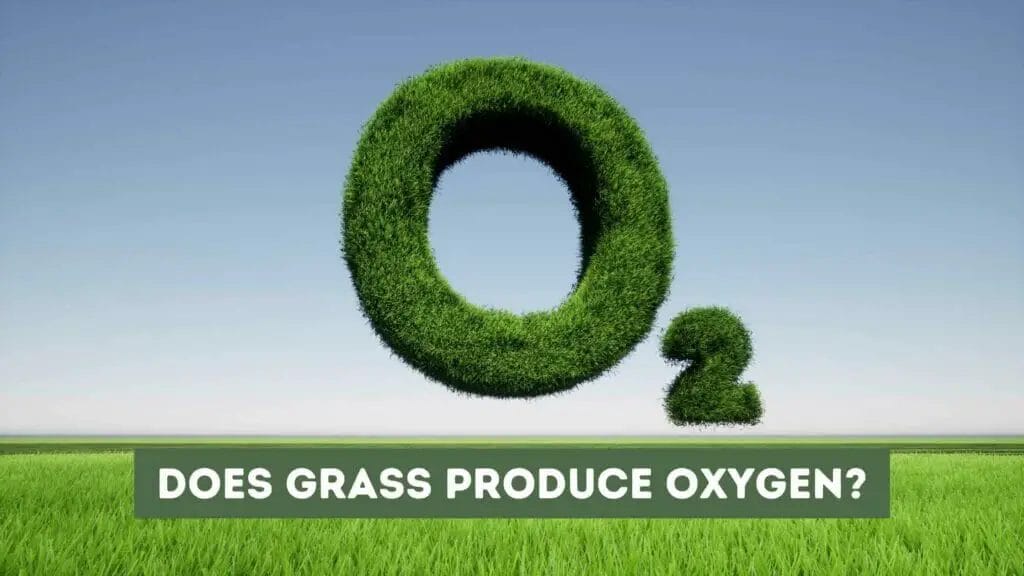
You may have heard that trees are the primary source of oxygen, but does grass produce oxygen as well? Grass also plays a significant role in producing this vital gas. Through the process of photosynthesis, grass can convert carbon dioxide and water into glucose and oxygen. In fact, a 50ft² lawn can produce enough oxygen to meet the needs of a family of four each year.
While trees are certainly important for producing oxygen, grass can also make a significant contribution. In fact, an acre of grass can produce enough oxygen to meet the needs of 64 people per day. Additionally, a healthy green lawn is very efficient at producing oxygen, thanks to the chlorophyll in the plant’s cells that absorbs energy from sunlight and carbon dioxide from the air.
So, the next time you take a deep breath of fresh air while enjoying a lush green lawn, you can thank the grass for its role in producing the oxygen that keeps us all breathing. Keep reading to learn more about how grass produces oxygen and the benefits of a healthy lawn.
Key takeaways:
Understanding Photosynthesis
Photosynthesis is the process by which plants create energy in the form of sugar and oxygen using sunlight, water, and carbon dioxide. This process is essential for the survival of most living organisms on Earth, as it is responsible for producing the oxygen we breathe.
Role of Sunlight and Water
Sunlight plays a crucial role in the photosynthesis process. Chlorophyll, a pigment found in plant cells, absorbs sunlight and converts it into energy. This energy is then used to split water molecules into oxygen and hydrogen. The oxygen is released into the atmosphere, while the hydrogen is used to create glucose, the sugar that fuels the plant’s growth.
The Process of Photosynthesis
Photosynthesis can be broken down into two main stages: light-dependent reactions and dark reactions. During the light-dependent reactions, chlorophyll absorbs sunlight and uses the energy to create ATP, a molecule that stores energy. This energy is then used to power the dark reactions, where carbon dioxide is converted into glucose.
Grass, like most plants, uses photosynthesis to create energy. The amount of oxygen produced by grass varies depending on the amount of chlorophyll present in the plant. While grass may not produce as much oxygen as trees, it still plays a vital role in the photosynthesis process and contributes to the oxygen levels in the atmosphere.
Oxygen Production in Grass
Grass is one of the plants that produce oxygen through the process of photosynthesis. During this process, the chlorophyll in the plant’s cells absorbs energy from sunlight and carbon dioxide from the air. The energy is then used to convert the carbon dioxide and water into glucose and oxygen. In this section, we will explore the efficiency of grass in producing oxygen, as well as the impact of mowing and watering on oxygen production.
Efficiency of Grass in Producing Oxygen
A healthy lawn is very efficient at producing oxygen. In fact, a 50ft² lawn can create enough oxygen per annum to meet the oxygen needs of a family of four. An acre of grass will produce enough oxygen for 64 people per day. This makes grass an excellent producer of oxygen, even better than some trees.
Impact of Mowing and Watering on Oxygen Production
Mowing and watering can have an impact on the amount of oxygen produced by grass. When grass is mowed, the amount of green surface area is reduced, which can decrease the amount of oxygen produced. However, regular mowing can also stimulate grass growth, which can lead to increased oxygen production over time.
Watering is also important for oxygen production. Grass needs water to carry out photosynthesis, so if it is not getting enough water, it will not produce as much oxygen. However, overwatering can lead to root rot and other problems, which can also decrease oxygen production.
To maximize oxygen production from your lawn, it is important to mow and water it properly. Here are some tips:
- Mow your lawn regularly, but do not cut it too short. A height of 2-3 inches is ideal.
- Water your lawn deeply and infrequently rather than frequently and shallowly. This will encourage deep-root growth and better oxygen production.
- Use a mulching mower to leave grass clippings on the lawn. This can help to fertilize the lawn and promote healthy growth, which will lead to increased oxygen production over time.
Grass and Carbon Dioxide
When it comes to producing oxygen, grass is not as efficient as trees. However, it still plays an important role in the carbon cycle. In this section, we will explore the relationship between grass and carbon dioxide.
Grass and Carbon Sequestration
Grass is a plant that absorbs carbon dioxide from the atmosphere through photosynthesis. During this process, the plant converts carbon dioxide and water into glucose and oxygen. The glucose is used for energy, while the oxygen is released back into the atmosphere.
Grass also plays a role in carbon sequestration, which is the process of capturing and storing carbon dioxide from the atmosphere. When grass dies, it decomposes and releases carbon dioxide back into the atmosphere.
However, if the grass is left to decompose naturally, the carbon can be stored in the soil. This is because the decomposing grass releases carbon into the soil, which can be absorbed by microorganisms and stored as organic matter.
Impact of Fertilizers on Grass and Carbon Dioxide
Fertilizers can have both positive and negative impacts on the relationship between grass and carbon dioxide. On one hand, fertilizers can increase the growth rate of grass, which can lead to more carbon dioxide being absorbed from the atmosphere. However, fertilizers can also release nitrous oxide, which is a potent greenhouse gas that contributes to global warming.
To minimize the negative impact of fertilizers on carbon dioxide levels, it is important to use fertilizers responsibly. This means using the right amount of fertilizer at the right time and in the right place. It is also important to choose fertilizers that are low in nitrogen, as nitrogen is the main contributor to nitrous oxide emissions.
Grasslands and Ecosystem
Grasslands are an essential part of the ecosystem, covering nearly a quarter of the Earth’s land surface. These vast expanses of grasses and scattered trees provide a habitat for a diverse range of plant and animal species. In this section, we will explore the role of grasslands in the ecosystem and how they affect air quality.
Role of Grasslands in Ecosystem
Grasslands are home to a wide variety of plant and animal species, many of which are unique to these habitats. Grasses are the primary producers in grassland ecosystems, converting sunlight into energy through the process of photosynthesis. They play a critical role in the food chain, providing food for herbivores such as bison, antelope, and zebras, which in turn, are preyed upon by carnivores such as lions and wolves.
Grasslands also play a crucial role in carbon sequestration, helping to mitigate the effects of climate change. The deep root systems of grasses store carbon in the soil, helping to reduce the amount of carbon dioxide in the atmosphere.
Grassland and Air Quality
Grasslands also play a vital role in air quality. They produce oxygen through the process of photosynthesis, which helps to improve air quality. Grasses also absorb carbon dioxide from the atmosphere, helping to reduce the amount of this greenhouse gas in the air.
In addition to producing oxygen and absorbing carbon dioxide, grasslands also help to reduce air pollution. The leaves of grasses and other plants trap dust and other pollutants, preventing them from entering the air we breathe.
Grasslands are also important for water quality. The deep root systems of grasses help to prevent soil erosion, which can lead to sedimentation and pollution of waterways. They also help to filter pollutants from water as it passes through the soil.
Comparative Analysis
When it comes to oxygen production, grass is often overlooked in favor of trees and marine life. However, grass is actually a significant contributor to the oxygen we breathe. In this section, we will compare the oxygen production of grass to that of trees and marine life.
Grass vs Trees
While trees are often touted as the ultimate oxygen producers, grass actually produces more oxygen per unit area. According to research, a 50 ft x 50 ft lawn produces enough oxygen to meet the needs of a family of four, while an acre of grass can produce enough oxygen for 64 people per day. In comparison, an acre of trees can produce enough oxygen for only 18 people per day.
It’s important to note that trees are still incredibly important for oxygen production, as they cover a much larger area and provide other benefits such as carbon sequestration and habitat for wildlife. However, grass should not be underestimated in its contribution to our oxygen supply.
Grass vs Marine Life
Marine life, particularly phytoplankton and other forms of plankton are also major oxygen producers. In fact, they are responsible for producing around 50% of the oxygen we breathe. However, the production of oxygen by marine life is dependent on the health of our oceans, which are currently facing significant challenges such as pollution and climate change.
Grass, on the other hand, is much more resilient and can be grown in a variety of environments. While it may not produce as much oxygen as marine life, it is a more reliable source of oxygen production.
Grass and the Environment
Grass is not only a beautiful addition to your landscape, but it also plays an important role in the environment. In this section, we will explore how grass helps to prevent soil erosion and reduce greenhouse gas emissions.
Grass and Soil Erosion
Grass has an extensive root system that helps to hold soil in place, preventing soil erosion. When it rains, the roots of the grass absorb the water, reducing the amount of runoff that occurs. This helps to prevent soil from washing away and keeps it in place, which is important for maintaining healthy soil for plant growth.
Grass also helps to improve soil structure by adding organic matter to the soil. As the grass dies and decomposes, it adds nutrients to the soil, making it more fertile and better able to support plant growth.
Grass and Greenhouse Gas Emissions
Grass plays an important role in reducing greenhouse gas emissions. As grass grows, it absorbs carbon dioxide from the atmosphere through photosynthesis. This process helps to reduce the amount of carbon dioxide in the atmosphere, which is a major contributor to climate change.
Grass also helps to reduce the carbon footprint of your property. A healthy lawn can absorb up to 300 pounds of carbon per year, which is equivalent to the emissions from driving a car for 2000 miles.
By maintaining a healthy lawn, you can help to reduce your carbon footprint and contribute to a healthier planet.
Other Interesting Facts
University of Michigan Study on Grass Oxygen Production
Did you know that a study conducted by the University of Michigan found that a well-maintained lawn can produce enough oxygen for a family of four? The study found that a 50 by 50 feet green lawn produces enough oxygen for a family of four to breathe for an entire day. That’s impressive, right?
Grass and a Family of Four
If you’re a family of four, you’ll be happy to know that a healthy lawn can provide enough oxygen for your family’s daily needs. And not only that, but a well-maintained lawn can also help reduce the amount of carbon dioxide in the air. This is because grass absorbs carbon dioxide and releases oxygen during photosynthesis.
So, if you want to keep your family healthy and improve the air quality around your house, make sure to take good care of your lawn. This means watering it regularly, mowing it at the right height, and fertilizing it when necessary.
Other Interesting Facts
Did you know that a healthy lawn can also:
- Improve air quality by trapping airborne dust particles and other contaminants
- Reduce the air temperature surrounding your home by up to 14°F
- Absorb up to 10 times more carbon than previously thought, according to a study by the University of Illinois at Urbana-Champaign
- Act as a natural water filter, helping to prevent water pollution
- Increase the value of your property by up to 15%
FAQ: Does Grass Produce Oxygen?
Does grass produce more oxygen than trees?
Grass does produce more oxygen than trees. Although trees are larger and have more leaves, they are not as efficient at producing oxygen as grass. A healthy lawn can produce enough oxygen to meet the needs of a family of four for a year.
Do weeds produce oxygen?
Yes, weeds do produce oxygen through photosynthesis, just like grass and other plants.
Does moss produce oxygen?
Yes, moss does produce oxygen through photosynthesis, but not as much as grass or other plants.
Do all plants produce oxygen?
No, not all plants produce oxygen. Only plants that use photosynthesis to convert carbon dioxide into energy produce oxygen as a byproduct.
Does grass help clean the air?
Yes, grass helps clean the air by absorbing pollutants and producing oxygen. A healthy lawn can absorb pollutants such as carbon dioxide, sulfur dioxide, and nitrogen oxide.
Does an acre of grass produce more oxygen than an acre of rainforest?
No, an acre of rainforest produces more oxygen than an acre of grass. Rainforests have a higher density of trees and other plants, which are very efficient at producing oxygen through photosynthesis. However, grass is still an important source of oxygen and helps to clean the air in urban and suburban areas.












